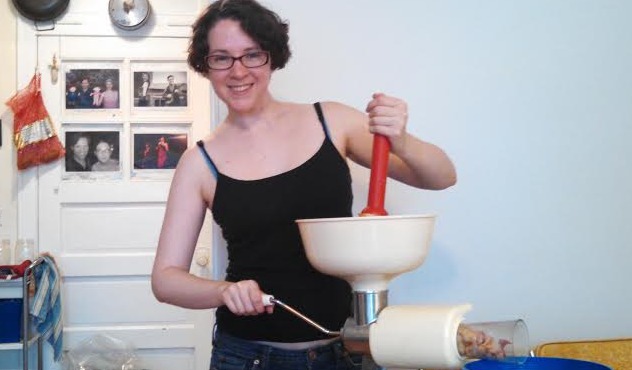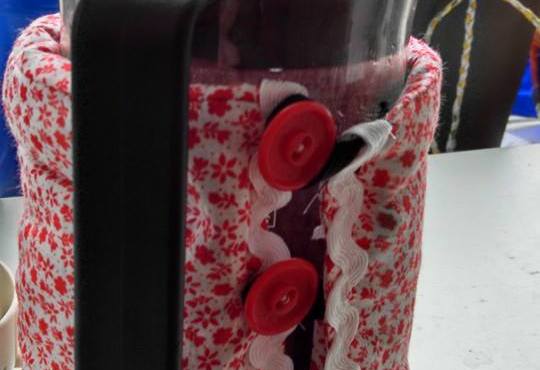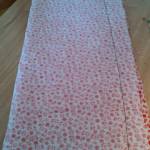Applesauce! Not just 1920’s slang to express disbelief, it’s also a delicious, inexpensive, and delightfully old-fashioned way of rounding out a meal. You can also use it to replace (some) fat in baked goods, which is handy. Commercial applesauce is not expensive, so this isn’t necessarily a case of saving money via DIY. I do think it’s cheaper to make your own organic, though. And I like supporting local farms when I can.
A couple of weeks ago, I made a bunch of applesauce. I headed down to the Glenwood Sunday Market to pick up a bushel of apples seconds from Earth First Farms. Earth First is an organic orchard in Southwest Michigan. They had a nice price on seconds–apples that aren’t pretty enough for regular sale, but are still plenty useful. I hauled my bushel home, and began a mad afternoon of applesaucing.
Applesauce is a good beginner canning project, as it does not require much special equipment and the process is simple. Over the years, I have acquired some equipment that definitely makes large scale projects simpler, but it’s not strictly necessary.
Of course, you don’t have to make a bushel’s worth of sauce, and you don’t need to can it. You can just make enough to enjoy as a side dish, if you’d rather. The directions are the same, whether you’re making a bowl or a bushel.
You will need:
- Apples. I used Jonathans, but you can use whatever kind you like, or a mixture.
- A big kettle to cook the apples in.
- Something with which to squish the apples. I use a foodstrainer-saucemaking-great big cranky thing, but you can use a hand held food mill, or, if you are really dedicated (I’m not) squish your apples through a sieve. Do not make a bushel’s worth of sauce if you plan to use a sieve. This way madness lies.
- You can use sugar. I don’t.
- Water for cooking the apples.
If you are canning the sauce, you will need.
- Canning jars. You can get these at the hardware store, or in the seasonal section of your grocery store. These can be reused.
- Canning lids. You have to use brand new lids every single time. Every. Single. Time.
- Canning bands. These are metal bands that hold the lids on during processing.
- A big kettle. Really big. A canner is ideal, for obvious reasons. However, you can use a giant pot if you can figure out some way to keep the jars off the bottom.
- A jar lifter. These are insulated tongs that are shaped to pick up jars. They are not expensive, and I have used them ever since my dad bought me one for Christmas, after fielding a phone call during a canning session in which I said, “I dropped a jar using barbeque tongs and splashed myself in the face with boiling water. What are the chances I am scarred for life?”
- Nice things to have include: a nifty little magnet for pulling lids out of hot water, a nifty little scraper to push the air out of the canned product, and a jar funnel. Everyone should have a jar funnel anyway, they are the best.
The steps are simple:
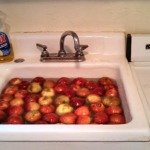
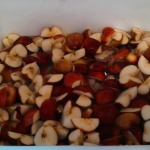


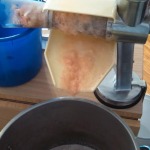
And there you have it. You can add sugar if you want, I don’t.
To can the applesauce, this is what I do. You should probably use more official instructions:
- Heat the applesauce to boiling.
- Put the lids in hot, but not boiling, water. This will soften them to promote a good seal.
- Ladle the hot, hot, oh-so-hot applesauce into clean, hot canning jars. Leave half an inch of space at the top. This is called “headspace” and it helps jars seal and not explode.
- Wipe off any applesauce from the rim of the jars with a towel. Or a paper towel. Whatever.
- Put on brand new lids.
- Screw on the bands tightly.
- Process in a boiling water bath for 20 minutes. This means you put the jars into boiling water with your jar lifter, making sure the water covers them completely, and comes at least one inch over the tops. Once the water returns to boiling, start your 20 minute timer.
- After they’ve been in the bath boiling away for 20 minutes, remove from water with jar lifter, and allow to cool. Listen for the satisfying “ping” of the lids sealing.
- After 24 hours, if all have sealed, remove the bands.
NOTE: These are “boiling water bath” instructions. You can’t can everything safely via this method. Many foods require a pressure canner. Applesauce can be canned this way because apples are high enough in acid to not promote botulism and other nasties that can thrive in a jar.

